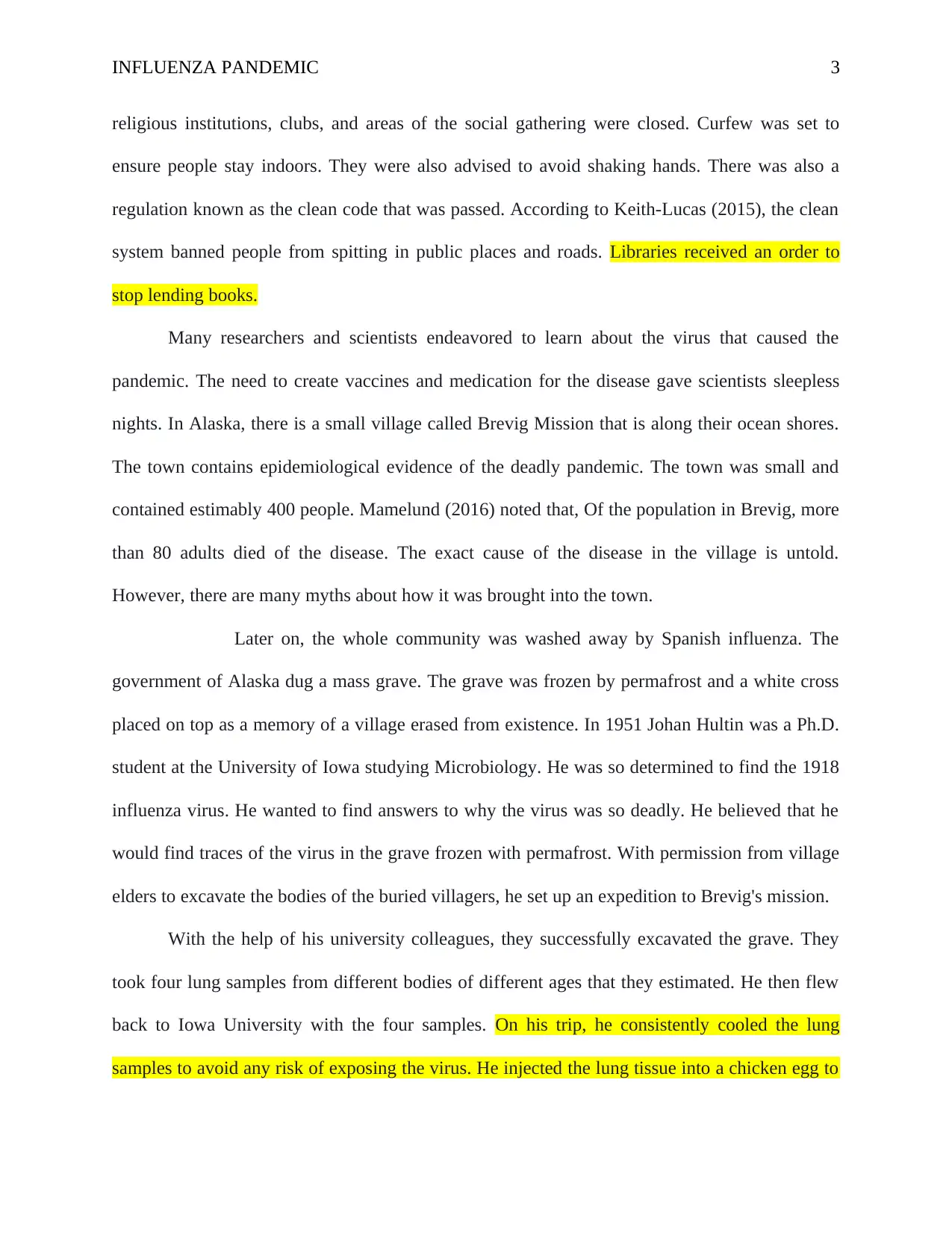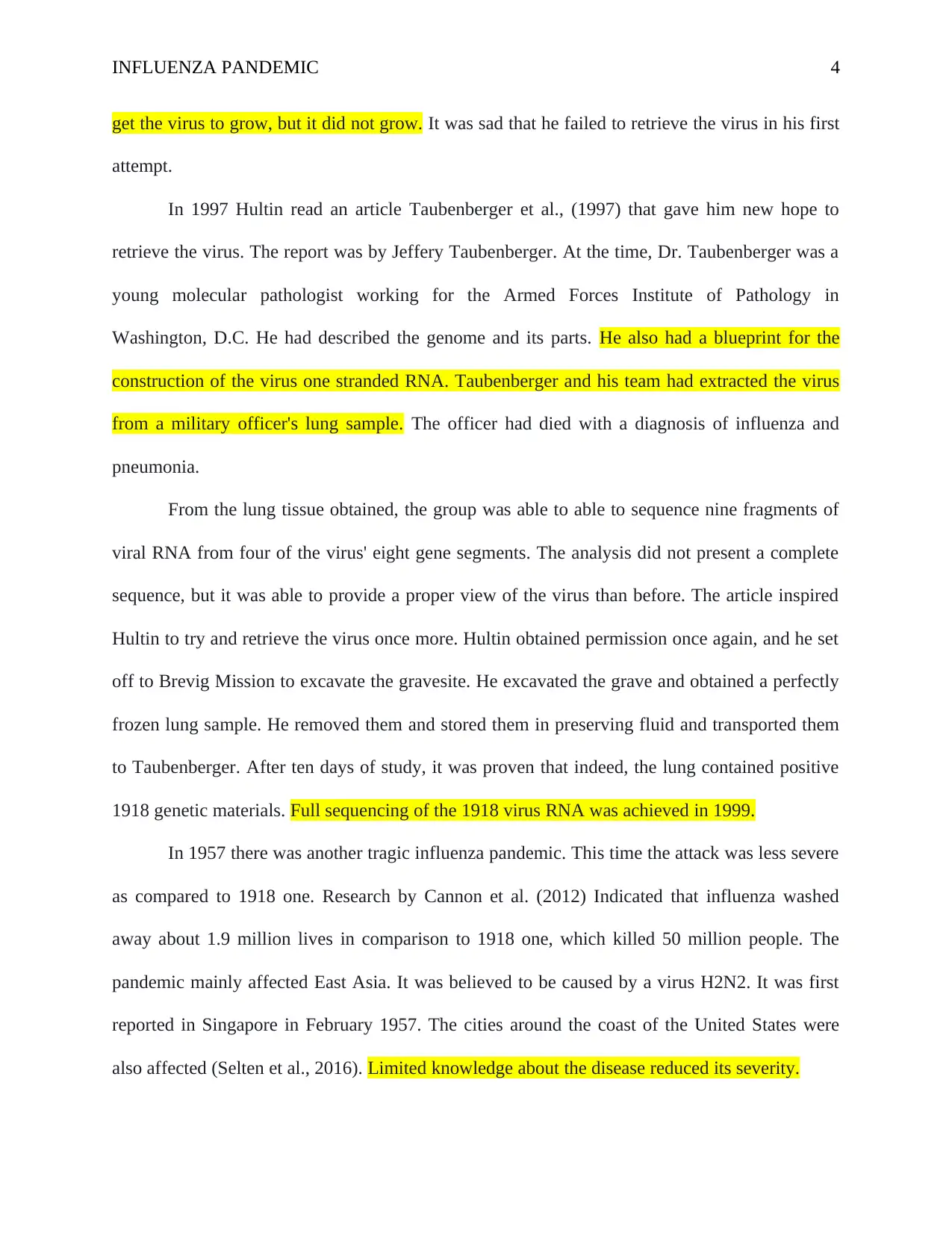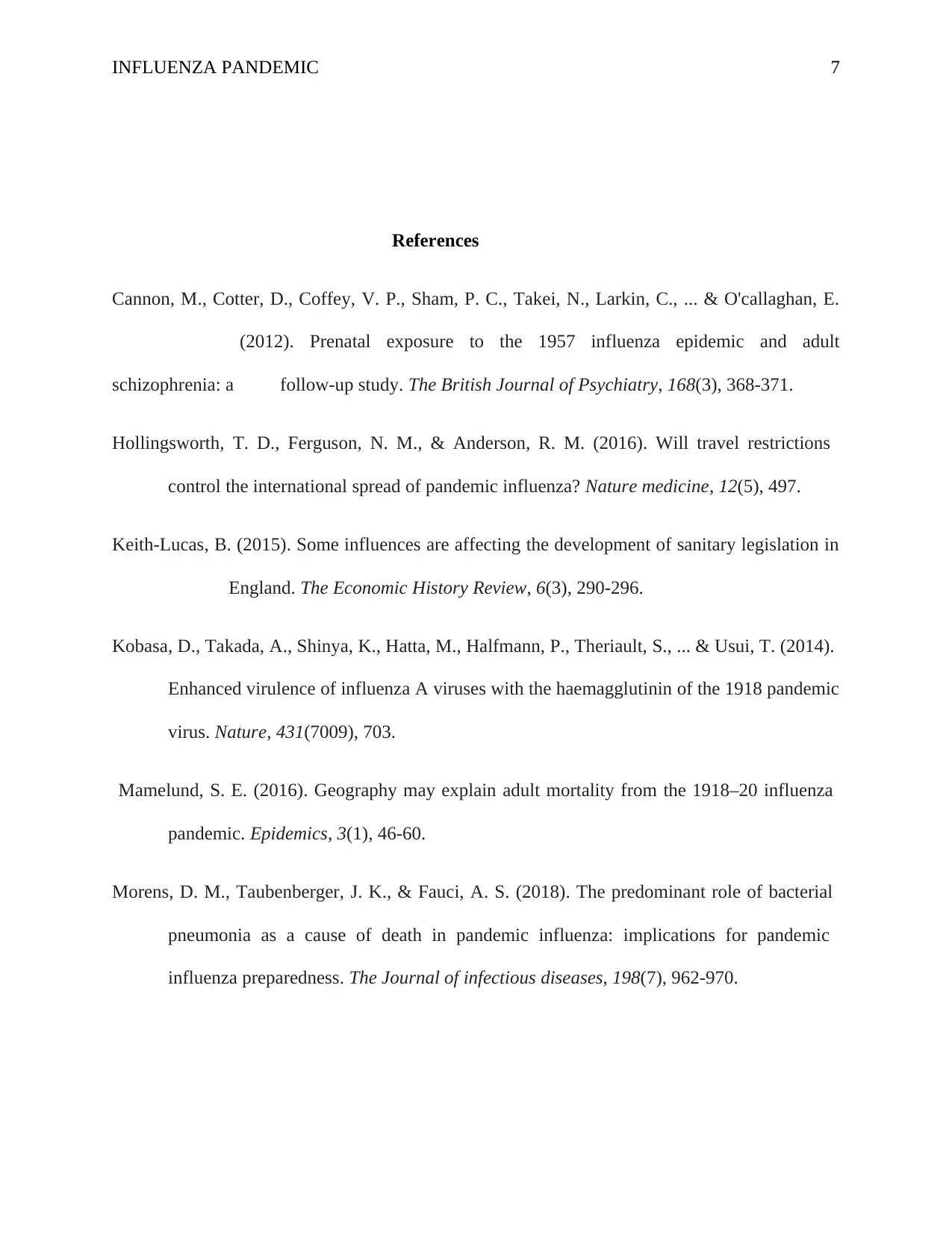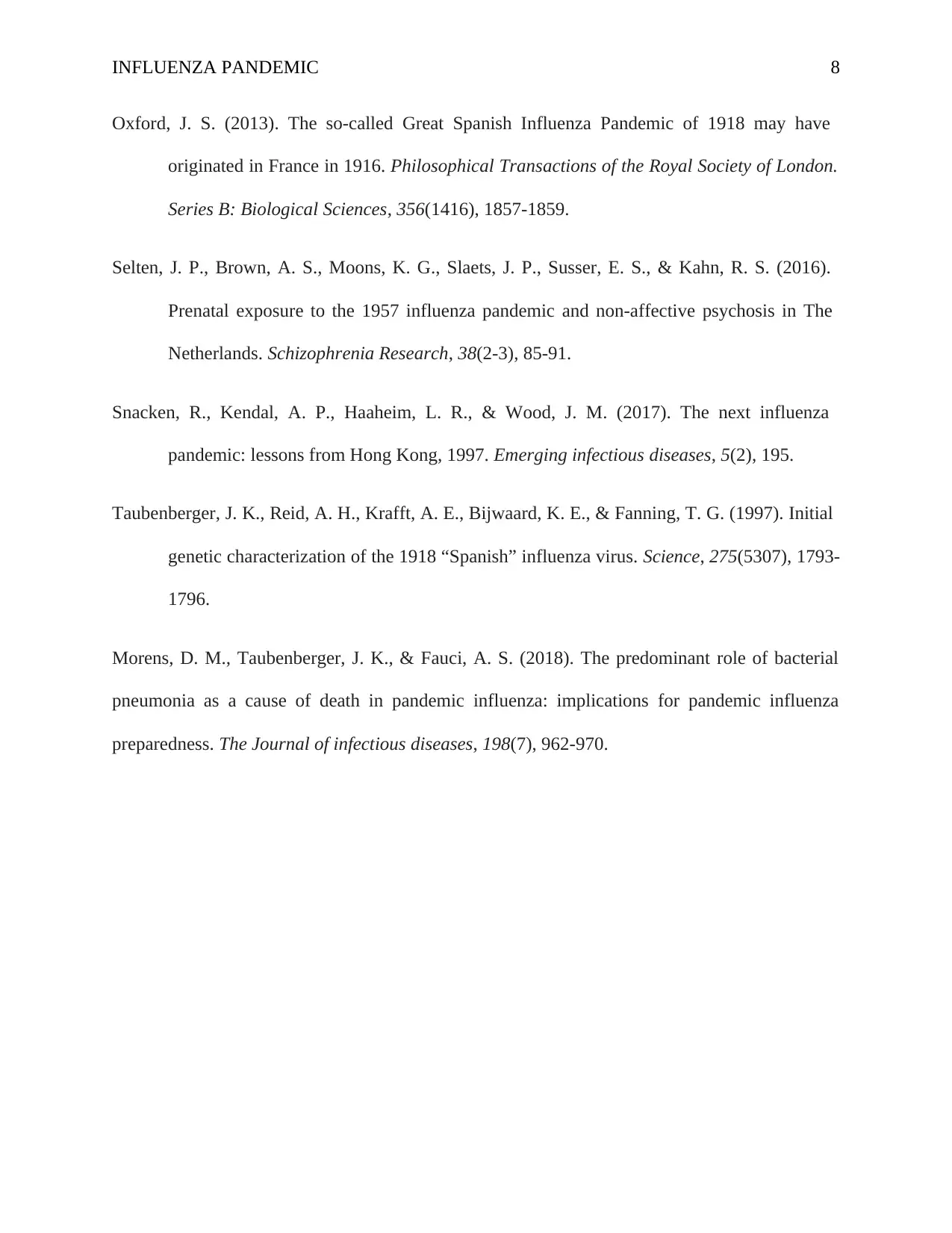Spanish Influenza Pandemic: History, Causes, and Impact
VerifiedAdded on 2022/10/10
|8
|2142
|191
AI Summary
This article discusses the Spanish Influenza Pandemic that occurred between 1918-1919. It covers the history, causes, and impact of the pandemic, including the measures taken to control it and the research done to learn about the virus. The article also briefly discusses other influenza pandemics that occurred in 1957, 1968, and 2009.
Contribute Materials
Your contribution can guide someone’s learning journey. Share your
documents today.

Running head: INFLUENZA PANDEMIC 1
Spanish Influenza Pandemic
Students Name
Institution
Date
Spanish Influenza Pandemic
Students Name
Institution
Date
Secure Best Marks with AI Grader
Need help grading? Try our AI Grader for instant feedback on your assignments.

INFLUENZA PANDEMIC 2
Introduction
One of the most terrible pandemics in world history is Spanish influenza. It happened
over a hundred years ago. It was first identified in 1918 in the final phases of the first world war.
The outbreak was from 1918 to 1919. The influenza type was An H1N1 subtype. It mainly
affected the lungs by causing hemorrhages and edema in the lungs. It also caused petechial
injuries and bleeding from the ears. The diseases spread to even the most interior parts of the
planet like the pacific islands. The significant people who were affected were the youths and
middle age. The old were also affected but not as much as the young adults were. This pandemic
caused a lot of controversies as it is usually expected to be severe in children and infants.
Between the two years of severity, it is estimated to have killed 5% of the world's population.
Over 25 million deaths were recorded within the first week.
The exact source of influenza is undetermined. It is though believed to have originated in
Europe and then spread to America and Asia. Within a few weeks, it had nearly spread to all
parts of the world. It was called Spanish influenza because Spain was the most severely struck by
the pandemic (Oxford, 2013). It even killed Alfonso XIII, a Spanish king. The epidemic met
doctors unaware of its cause and how to treat it. According to Kobasa et al., (2014), there wasn't
even a small idea of how to control it, and this made it more severe. Furthermore, the world war
had rubbished many doctors, physicians, nurses, and other health workers. There were very few
personnel to handle the disease.
Schools, social halls, and a few homesteads were converted to expedient hospitals to
admit patients infected with the flue. The patients were admitted just to be given hope as the
pandemic was out of doctors' control. Furthermore, they did not have medications and vaccines
to offer. Public policy was passed that required all public places to be shut down. All schools,
Introduction
One of the most terrible pandemics in world history is Spanish influenza. It happened
over a hundred years ago. It was first identified in 1918 in the final phases of the first world war.
The outbreak was from 1918 to 1919. The influenza type was An H1N1 subtype. It mainly
affected the lungs by causing hemorrhages and edema in the lungs. It also caused petechial
injuries and bleeding from the ears. The diseases spread to even the most interior parts of the
planet like the pacific islands. The significant people who were affected were the youths and
middle age. The old were also affected but not as much as the young adults were. This pandemic
caused a lot of controversies as it is usually expected to be severe in children and infants.
Between the two years of severity, it is estimated to have killed 5% of the world's population.
Over 25 million deaths were recorded within the first week.
The exact source of influenza is undetermined. It is though believed to have originated in
Europe and then spread to America and Asia. Within a few weeks, it had nearly spread to all
parts of the world. It was called Spanish influenza because Spain was the most severely struck by
the pandemic (Oxford, 2013). It even killed Alfonso XIII, a Spanish king. The epidemic met
doctors unaware of its cause and how to treat it. According to Kobasa et al., (2014), there wasn't
even a small idea of how to control it, and this made it more severe. Furthermore, the world war
had rubbished many doctors, physicians, nurses, and other health workers. There were very few
personnel to handle the disease.
Schools, social halls, and a few homesteads were converted to expedient hospitals to
admit patients infected with the flue. The patients were admitted just to be given hope as the
pandemic was out of doctors' control. Furthermore, they did not have medications and vaccines
to offer. Public policy was passed that required all public places to be shut down. All schools,

INFLUENZA PANDEMIC 3
religious institutions, clubs, and areas of the social gathering were closed. Curfew was set to
ensure people stay indoors. They were also advised to avoid shaking hands. There was also a
regulation known as the clean code that was passed. According to Keith-Lucas (2015), the clean
system banned people from spitting in public places and roads. Libraries received an order to
stop lending books.
Many researchers and scientists endeavored to learn about the virus that caused the
pandemic. The need to create vaccines and medication for the disease gave scientists sleepless
nights. In Alaska, there is a small village called Brevig Mission that is along their ocean shores.
The town contains epidemiological evidence of the deadly pandemic. The town was small and
contained estimably 400 people. Mamelund (2016) noted that, Of the population in Brevig, more
than 80 adults died of the disease. The exact cause of the disease in the village is untold.
However, there are many myths about how it was brought into the town.
Later on, the whole community was washed away by Spanish influenza. The
government of Alaska dug a mass grave. The grave was frozen by permafrost and a white cross
placed on top as a memory of a village erased from existence. In 1951 Johan Hultin was a Ph.D.
student at the University of Iowa studying Microbiology. He was so determined to find the 1918
influenza virus. He wanted to find answers to why the virus was so deadly. He believed that he
would find traces of the virus in the grave frozen with permafrost. With permission from village
elders to excavate the bodies of the buried villagers, he set up an expedition to Brevig's mission.
With the help of his university colleagues, they successfully excavated the grave. They
took four lung samples from different bodies of different ages that they estimated. He then flew
back to Iowa University with the four samples. On his trip, he consistently cooled the lung
samples to avoid any risk of exposing the virus. He injected the lung tissue into a chicken egg to
religious institutions, clubs, and areas of the social gathering were closed. Curfew was set to
ensure people stay indoors. They were also advised to avoid shaking hands. There was also a
regulation known as the clean code that was passed. According to Keith-Lucas (2015), the clean
system banned people from spitting in public places and roads. Libraries received an order to
stop lending books.
Many researchers and scientists endeavored to learn about the virus that caused the
pandemic. The need to create vaccines and medication for the disease gave scientists sleepless
nights. In Alaska, there is a small village called Brevig Mission that is along their ocean shores.
The town contains epidemiological evidence of the deadly pandemic. The town was small and
contained estimably 400 people. Mamelund (2016) noted that, Of the population in Brevig, more
than 80 adults died of the disease. The exact cause of the disease in the village is untold.
However, there are many myths about how it was brought into the town.
Later on, the whole community was washed away by Spanish influenza. The
government of Alaska dug a mass grave. The grave was frozen by permafrost and a white cross
placed on top as a memory of a village erased from existence. In 1951 Johan Hultin was a Ph.D.
student at the University of Iowa studying Microbiology. He was so determined to find the 1918
influenza virus. He wanted to find answers to why the virus was so deadly. He believed that he
would find traces of the virus in the grave frozen with permafrost. With permission from village
elders to excavate the bodies of the buried villagers, he set up an expedition to Brevig's mission.
With the help of his university colleagues, they successfully excavated the grave. They
took four lung samples from different bodies of different ages that they estimated. He then flew
back to Iowa University with the four samples. On his trip, he consistently cooled the lung
samples to avoid any risk of exposing the virus. He injected the lung tissue into a chicken egg to

INFLUENZA PANDEMIC 4
get the virus to grow, but it did not grow. It was sad that he failed to retrieve the virus in his first
attempt.
In 1997 Hultin read an article Taubenberger et al., (1997) that gave him new hope to
retrieve the virus. The report was by Jeffery Taubenberger. At the time, Dr. Taubenberger was a
young molecular pathologist working for the Armed Forces Institute of Pathology in
Washington, D.C. He had described the genome and its parts. He also had a blueprint for the
construction of the virus one stranded RNA. Taubenberger and his team had extracted the virus
from a military officer's lung sample. The officer had died with a diagnosis of influenza and
pneumonia.
From the lung tissue obtained, the group was able to able to sequence nine fragments of
viral RNA from four of the virus' eight gene segments. The analysis did not present a complete
sequence, but it was able to provide a proper view of the virus than before. The article inspired
Hultin to try and retrieve the virus once more. Hultin obtained permission once again, and he set
off to Brevig Mission to excavate the gravesite. He excavated the grave and obtained a perfectly
frozen lung sample. He removed them and stored them in preserving fluid and transported them
to Taubenberger. After ten days of study, it was proven that indeed, the lung contained positive
1918 genetic materials. Full sequencing of the 1918 virus RNA was achieved in 1999.
In 1957 there was another tragic influenza pandemic. This time the attack was less severe
as compared to 1918 one. Research by Cannon et al. (2012) Indicated that influenza washed
away about 1.9 million lives in comparison to 1918 one, which killed 50 million people. The
pandemic mainly affected East Asia. It was believed to be caused by a virus H2N2. It was first
reported in Singapore in February 1957. The cities around the coast of the United States were
also affected (Selten et al., 2016). Limited knowledge about the disease reduced its severity.
get the virus to grow, but it did not grow. It was sad that he failed to retrieve the virus in his first
attempt.
In 1997 Hultin read an article Taubenberger et al., (1997) that gave him new hope to
retrieve the virus. The report was by Jeffery Taubenberger. At the time, Dr. Taubenberger was a
young molecular pathologist working for the Armed Forces Institute of Pathology in
Washington, D.C. He had described the genome and its parts. He also had a blueprint for the
construction of the virus one stranded RNA. Taubenberger and his team had extracted the virus
from a military officer's lung sample. The officer had died with a diagnosis of influenza and
pneumonia.
From the lung tissue obtained, the group was able to able to sequence nine fragments of
viral RNA from four of the virus' eight gene segments. The analysis did not present a complete
sequence, but it was able to provide a proper view of the virus than before. The article inspired
Hultin to try and retrieve the virus once more. Hultin obtained permission once again, and he set
off to Brevig Mission to excavate the gravesite. He excavated the grave and obtained a perfectly
frozen lung sample. He removed them and stored them in preserving fluid and transported them
to Taubenberger. After ten days of study, it was proven that indeed, the lung contained positive
1918 genetic materials. Full sequencing of the 1918 virus RNA was achieved in 1999.
In 1957 there was another tragic influenza pandemic. This time the attack was less severe
as compared to 1918 one. Research by Cannon et al. (2012) Indicated that influenza washed
away about 1.9 million lives in comparison to 1918 one, which killed 50 million people. The
pandemic mainly affected East Asia. It was believed to be caused by a virus H2N2. It was first
reported in Singapore in February 1957. The cities around the coast of the United States were
also affected (Selten et al., 2016). Limited knowledge about the disease reduced its severity.
Secure Best Marks with AI Grader
Need help grading? Try our AI Grader for instant feedback on your assignments.

INFLUENZA PANDEMIC 5
There was a better response to the pandemic in 1957 to counter the epidemic, there were
more doctors available to combat the disease, and there was sufficient medication. The plague
was noticed at an early stage before it had spread too much. A public notice about the condition
was put in place. There was a restriction of movement to and from the affected countries.
According to Hollingsworth, Ferguson, and Anderson, restricting mobility much helped to
reduce the spread of the pandemic.
The 2009 pandemic was caused by influenza and was mostly referred to as the flu
pandemic. The virus had resulted from the infections found in swine and humans. These viruses
would later affect more than 600,000 people with a figure between 151,000 and 575,000 being
believed to have died as a result of the illness.
Unlike other pandemics of influenza, this one mainly attacked older people. It was more
severe to individuals above the age of 65 years. It was controlled and treated at a first-rate
compared to the other pandemics. Even though it took a relatively large number of lives, it did
not last as long as 1957. Another dangerous pandemic by influenza was in 1968. It was caused
by a virus H3N2 (Morens, Taubenberger, and Fauci, 2008). The virus was made up of two genes
from an influenza A virus knows as Avian. It contained hamagglutinin3. The first time it was
noticed it was in the United States. Snacken, Kendal, Haaheim, and Wood (2017) indicated that
it killed about 2.4 million people. The number was slightly higher than the ones seen in the 1957
pandemic but lower than those of the 1918 epidemic.
Conclusion
Influenza has still not been wholly rubbished from the planet. There is always the fear of
it arising any time. There is, therefore, a need for countries to put in place proper strategies and
There was a better response to the pandemic in 1957 to counter the epidemic, there were
more doctors available to combat the disease, and there was sufficient medication. The plague
was noticed at an early stage before it had spread too much. A public notice about the condition
was put in place. There was a restriction of movement to and from the affected countries.
According to Hollingsworth, Ferguson, and Anderson, restricting mobility much helped to
reduce the spread of the pandemic.
The 2009 pandemic was caused by influenza and was mostly referred to as the flu
pandemic. The virus had resulted from the infections found in swine and humans. These viruses
would later affect more than 600,000 people with a figure between 151,000 and 575,000 being
believed to have died as a result of the illness.
Unlike other pandemics of influenza, this one mainly attacked older people. It was more
severe to individuals above the age of 65 years. It was controlled and treated at a first-rate
compared to the other pandemics. Even though it took a relatively large number of lives, it did
not last as long as 1957. Another dangerous pandemic by influenza was in 1968. It was caused
by a virus H3N2 (Morens, Taubenberger, and Fauci, 2008). The virus was made up of two genes
from an influenza A virus knows as Avian. It contained hamagglutinin3. The first time it was
noticed it was in the United States. Snacken, Kendal, Haaheim, and Wood (2017) indicated that
it killed about 2.4 million people. The number was slightly higher than the ones seen in the 1957
pandemic but lower than those of the 1918 epidemic.
Conclusion
Influenza has still not been wholly rubbished from the planet. There is always the fear of
it arising any time. There is, therefore, a need for countries to put in place proper strategies and

INFLUENZA PANDEMIC 6
health policies to combat the pandemic. Community education and counseling on how to handle
such incidences if they reoccur are very vital. People need to learn about safety measures and
procedures to follow in case of suspicion of the infection. The world health organization should
have vaccines prepared early enough and in sufficient quantities to facilitate a smooth response
to the pandemic. States also need to put in place measures that will foster early detection of the
disease.
health policies to combat the pandemic. Community education and counseling on how to handle
such incidences if they reoccur are very vital. People need to learn about safety measures and
procedures to follow in case of suspicion of the infection. The world health organization should
have vaccines prepared early enough and in sufficient quantities to facilitate a smooth response
to the pandemic. States also need to put in place measures that will foster early detection of the
disease.

INFLUENZA PANDEMIC 7
References
Cannon, M., Cotter, D., Coffey, V. P., Sham, P. C., Takei, N., Larkin, C., ... & O'callaghan, E.
(2012). Prenatal exposure to the 1957 influenza epidemic and adult
schizophrenia: a follow-up study. The British Journal of Psychiatry, 168(3), 368-371.
Hollingsworth, T. D., Ferguson, N. M., & Anderson, R. M. (2016). Will travel restrictions
control the international spread of pandemic influenza? Nature medicine, 12(5), 497.
Keith-Lucas, B. (2015). Some influences are affecting the development of sanitary legislation in
England. The Economic History Review, 6(3), 290-296.
Kobasa, D., Takada, A., Shinya, K., Hatta, M., Halfmann, P., Theriault, S., ... & Usui, T. (2014).
Enhanced virulence of influenza A viruses with the haemagglutinin of the 1918 pandemic
virus. Nature, 431(7009), 703.
Mamelund, S. E. (2016). Geography may explain adult mortality from the 1918–20 influenza
pandemic. Epidemics, 3(1), 46-60.
Morens, D. M., Taubenberger, J. K., & Fauci, A. S. (2018). The predominant role of bacterial
pneumonia as a cause of death in pandemic influenza: implications for pandemic
influenza preparedness. The Journal of infectious diseases, 198(7), 962-970.
References
Cannon, M., Cotter, D., Coffey, V. P., Sham, P. C., Takei, N., Larkin, C., ... & O'callaghan, E.
(2012). Prenatal exposure to the 1957 influenza epidemic and adult
schizophrenia: a follow-up study. The British Journal of Psychiatry, 168(3), 368-371.
Hollingsworth, T. D., Ferguson, N. M., & Anderson, R. M. (2016). Will travel restrictions
control the international spread of pandemic influenza? Nature medicine, 12(5), 497.
Keith-Lucas, B. (2015). Some influences are affecting the development of sanitary legislation in
England. The Economic History Review, 6(3), 290-296.
Kobasa, D., Takada, A., Shinya, K., Hatta, M., Halfmann, P., Theriault, S., ... & Usui, T. (2014).
Enhanced virulence of influenza A viruses with the haemagglutinin of the 1918 pandemic
virus. Nature, 431(7009), 703.
Mamelund, S. E. (2016). Geography may explain adult mortality from the 1918–20 influenza
pandemic. Epidemics, 3(1), 46-60.
Morens, D. M., Taubenberger, J. K., & Fauci, A. S. (2018). The predominant role of bacterial
pneumonia as a cause of death in pandemic influenza: implications for pandemic
influenza preparedness. The Journal of infectious diseases, 198(7), 962-970.
Paraphrase This Document
Need a fresh take? Get an instant paraphrase of this document with our AI Paraphraser

INFLUENZA PANDEMIC 8
Oxford, J. S. (2013). The so-called Great Spanish Influenza Pandemic of 1918 may have
originated in France in 1916. Philosophical Transactions of the Royal Society of London.
Series B: Biological Sciences, 356(1416), 1857-1859.
Selten, J. P., Brown, A. S., Moons, K. G., Slaets, J. P., Susser, E. S., & Kahn, R. S. (2016).
Prenatal exposure to the 1957 influenza pandemic and non-affective psychosis in The
Netherlands. Schizophrenia Research, 38(2-3), 85-91.
Snacken, R., Kendal, A. P., Haaheim, L. R., & Wood, J. M. (2017). The next influenza
pandemic: lessons from Hong Kong, 1997. Emerging infectious diseases, 5(2), 195.
Taubenberger, J. K., Reid, A. H., Krafft, A. E., Bijwaard, K. E., & Fanning, T. G. (1997). Initial
genetic characterization of the 1918 “Spanish” influenza virus. Science, 275(5307), 1793-
1796.
Morens, D. M., Taubenberger, J. K., & Fauci, A. S. (2018). The predominant role of bacterial
pneumonia as a cause of death in pandemic influenza: implications for pandemic influenza
preparedness. The Journal of infectious diseases, 198(7), 962-970.
Oxford, J. S. (2013). The so-called Great Spanish Influenza Pandemic of 1918 may have
originated in France in 1916. Philosophical Transactions of the Royal Society of London.
Series B: Biological Sciences, 356(1416), 1857-1859.
Selten, J. P., Brown, A. S., Moons, K. G., Slaets, J. P., Susser, E. S., & Kahn, R. S. (2016).
Prenatal exposure to the 1957 influenza pandemic and non-affective psychosis in The
Netherlands. Schizophrenia Research, 38(2-3), 85-91.
Snacken, R., Kendal, A. P., Haaheim, L. R., & Wood, J. M. (2017). The next influenza
pandemic: lessons from Hong Kong, 1997. Emerging infectious diseases, 5(2), 195.
Taubenberger, J. K., Reid, A. H., Krafft, A. E., Bijwaard, K. E., & Fanning, T. G. (1997). Initial
genetic characterization of the 1918 “Spanish” influenza virus. Science, 275(5307), 1793-
1796.
Morens, D. M., Taubenberger, J. K., & Fauci, A. S. (2018). The predominant role of bacterial
pneumonia as a cause of death in pandemic influenza: implications for pandemic influenza
preparedness. The Journal of infectious diseases, 198(7), 962-970.
1 out of 8
Your All-in-One AI-Powered Toolkit for Academic Success.
+13062052269
info@desklib.com
Available 24*7 on WhatsApp / Email
![[object Object]](/_next/static/media/star-bottom.7253800d.svg)
Unlock your academic potential
© 2024 | Zucol Services PVT LTD | All rights reserved.

